BY DIANA FINERAN COPYRIGHT 1998 All
Rights Reserved
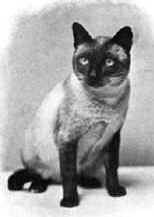 |
THE TRADITIONAL SIAMESE is a big boned, round faced, rounded
bodied, heavy, and extremely healthy cat. This is the original Siamese to
come out of Siam (Thailand) with all the loyalty, high intelligence and
talkative personality the Siamese breed is famous for. Champion Wankee
(above) is a Traditional Siamese. He was the very first Show Champion
Siamese in the late 1800's. |
| THE CLASSIC SIAMESE is a big boned cat, who is SLIGHTLY more
elongated all over than the Traditional Siamese. The Classic Siamese
head has a WIDE wedge shape to it, but is not extreme in any way. This is
the second original type to be imported from Siam (Thailand). It too
is the original Siamese, and is every bit as healthy as the Traditional
Siamese. Photo reporduced courtesy of Sheelagh Lecocq. |

Justin
|
THE COAT for both the Traditional Siamese and the Classic Siamese is
basically the same. It is short, and somewhat thick, which gives it a bit of
spring when touched. It has a wonderful soft feel.
|
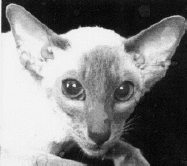
Buggsie
|
THE EXTREME WEDGE SIAMESE (MODERN) is an extreme cat in
every way. This is an extremely elongated, willowy, thin svelte cat with a
sharply pointed wedge shaped head topped with huge ears. The long nose and
the whole look of the head are exactly shaped like a piece of pie. Every
part of the body is long and thin to excess. This includes the neck, body,
legs and whip like tail. A general look of emaciation prevails through
out. Photo courtesy of Elsie Wilson. |
The Traditional Siamese and the Classic Siamese are the two body types that
came out of Siam (Thailand). The Extreme Wedge Siamese is a man made,
genetically engineered, derivative of the two original Siamese. Intense
inbreeding was used to manufacture the Extreme Wedge Siamese, which was brought
into existence to satisfy the political forces at work within the breed. This
took time. SLOWLY the breed was changed. The very first Siamese exported out of
Siam was the Traditional Siamese. As more cats were exported a second body type
became recognized and this is the Classic Siamese. Old books and old photographs
prove this. I would say sometime within the 1950’s the Extreme Wedge Siamese
began its metamorphosis into what it is today.
Until I came along in 1987 the only Siamese recognized worldwide was the
Extreme Wedge Siamese. After great amounts of research, study and looking at
many, many photos, I realized there were three body types for the Siamese breed.
At first I thought there was only two, the Traditional Siamese and the Extreme
Wedge Siamese. As I gathered more and more information and received testimonials
from owners. I came to the conclusion that there was a third body type and that
became known as the Classic Siamese. This took me some time-two years in fact-to
reach this conclusion. I had to have proof and I found it.
The next step was to give the Traditional Siamese and Classic
Siamese the support and recognition they deserved, after decades of languishing
in oblivion almost to extinction. I am the first person to write a Breed
Standard for the Traditional Siamese and the Classic Siamese. I hold Federal
Copyrights to both of these Breed Standards and many other Breed Standards that
I have written. Both Standards were reviewed and accepted by the membership of
TCA. Inc. at the time of their creation. Though copyrighted these Breed
Standards are available to those who request their use in order to keep the
breed uniform world wide. Copyright permission can only be obtained from Diana
Fineran, their Author. As we all know each cat association seems to
deem it fit to have different breed standards for each breed. I find this
nothing but nonsense. Uniformity is the right way to go for the breed. To
answer the questions why and how, the Siamese breed was changed, I offer this
explanation: Some say it was fads. It was really much more than that. Over time
and as the Siamese breed became ever more popular, more and more people became
involved in breeding them. Shows were invented, bringing competition about.
Certain breeders came into power in the resulting cat associations. Human ego,
greed and the desire to win blue ribbons no matter what it cost the cat caused
the degrading of the Siamese breed. These power hungry egomaniacs re-wrote the
Breed Standard, ignored the Breed Standard, became judges to have a direct
effect on the breed, and in general, pushed out any others who would not follow
their dictates. They promoted the cats in their own catteries to the exemption
of any other body type.
Through all of my reading I have not found any good reason as to why the
Extreme Wedge Siamese was created. The Traditional Siamese and the Classic
Siamese are healthy, genetically sound, long lived cats. The Extreme Wedge has
displayed a destroyed immune system and genetic predisposition to illness. Only
a very few bloodlines of the Extreme Wedge are healthy. Most live to be 2 to
5 years old and sadly die. Multiple testimonials are in my files about
kittens born, but who could not survive one day of life. Others tell me the
Extreme Wedge has a hyperactive, nervous personality. How anyone can justify
doing this to any breed or to any animal is beyond me!
Traditional Siamese breeding stock is rare worldwide. There seems to be more
Classic Siamese. I love them both and find each to have the wonderful, endearing
qualities that draws us to them and grips us for life.
(This article has also been published in the TCA, Inc. newsletter June 1998,
April 1999 Vol 54; The Traditional Cat Association Newsletter, Vol 3 #3 June
1998, Great Britain; All About Cats, Jan 25, 1999 Middx, Great Britain.) |
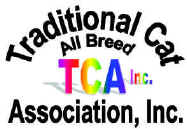
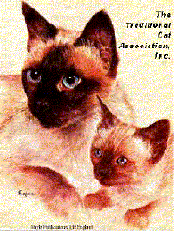 The
Traditional Cat Association,
Inc.©1987®TM
Official Website
The
Traditional Cat Association,
Inc.©1987®TM
Official Website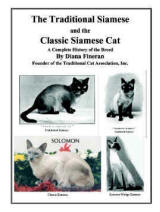
 Champion Wankee
Champion Wankee
